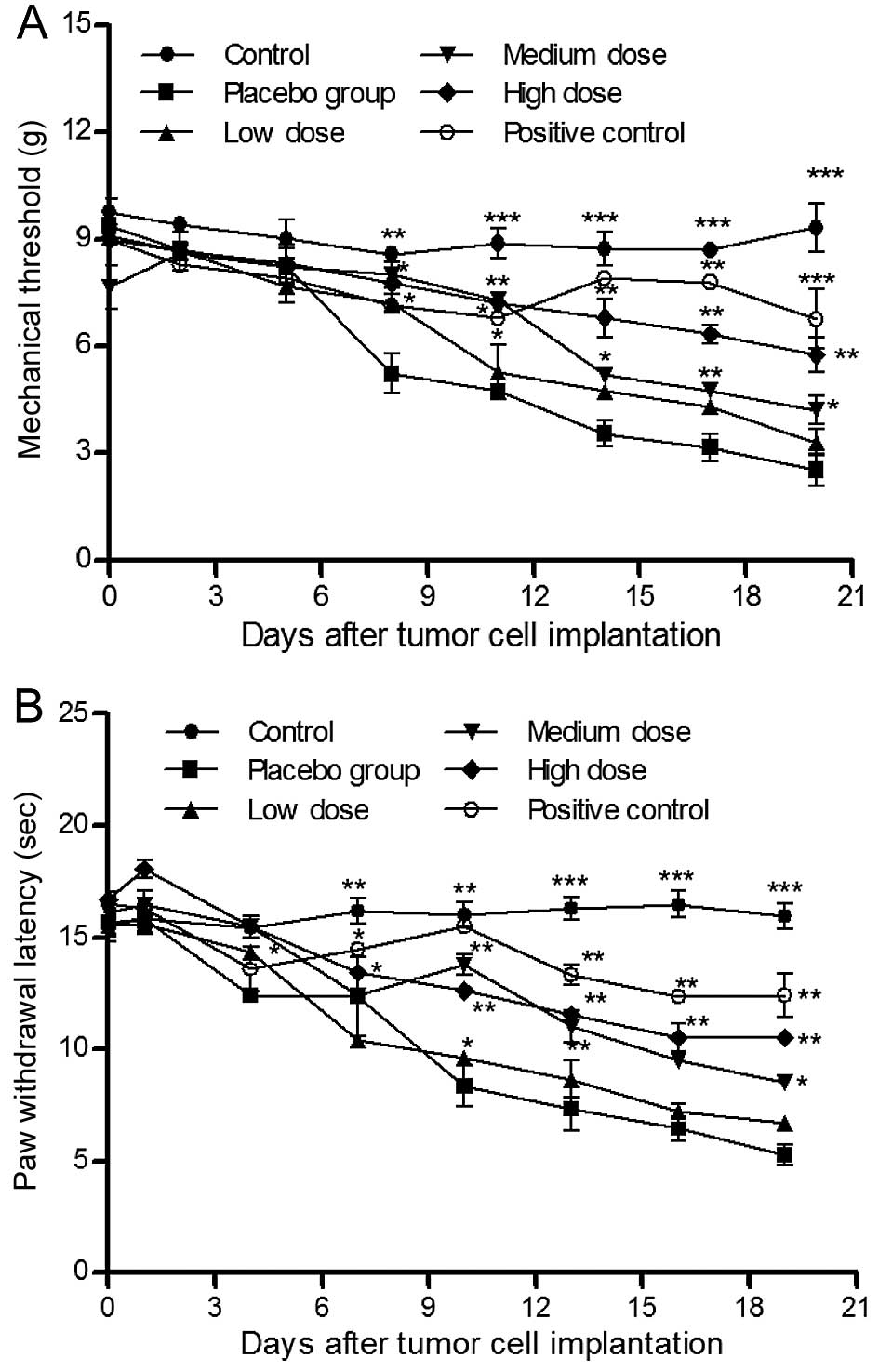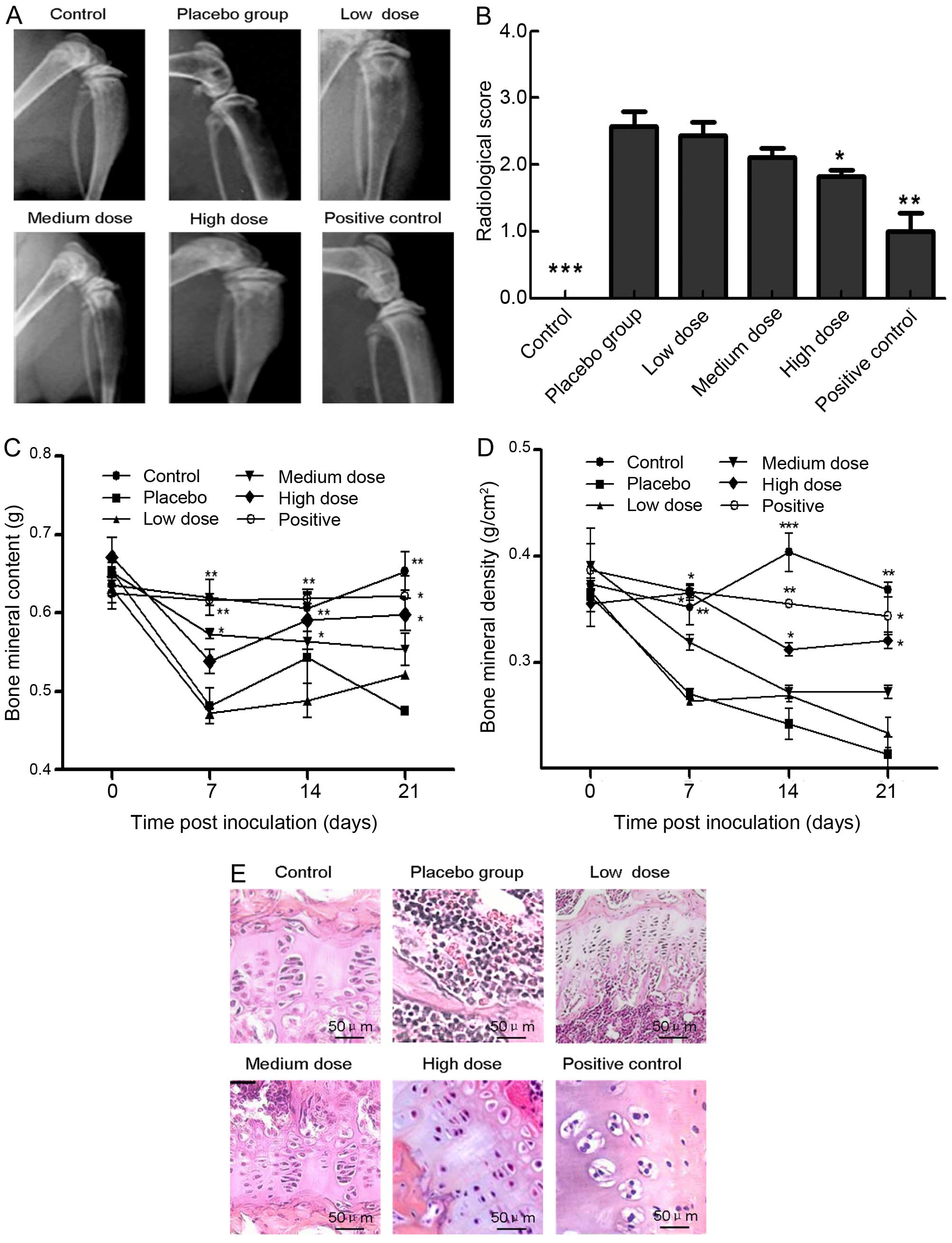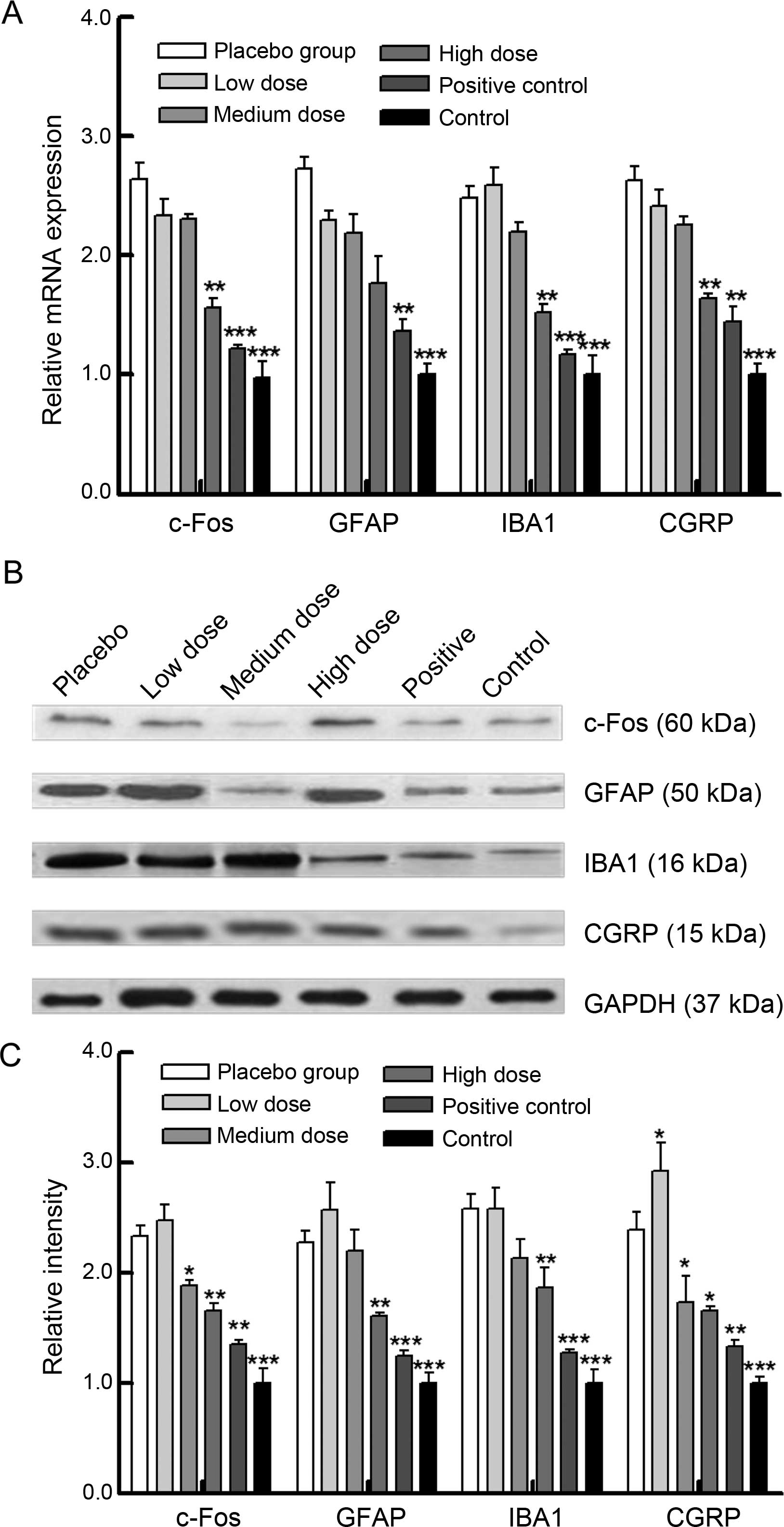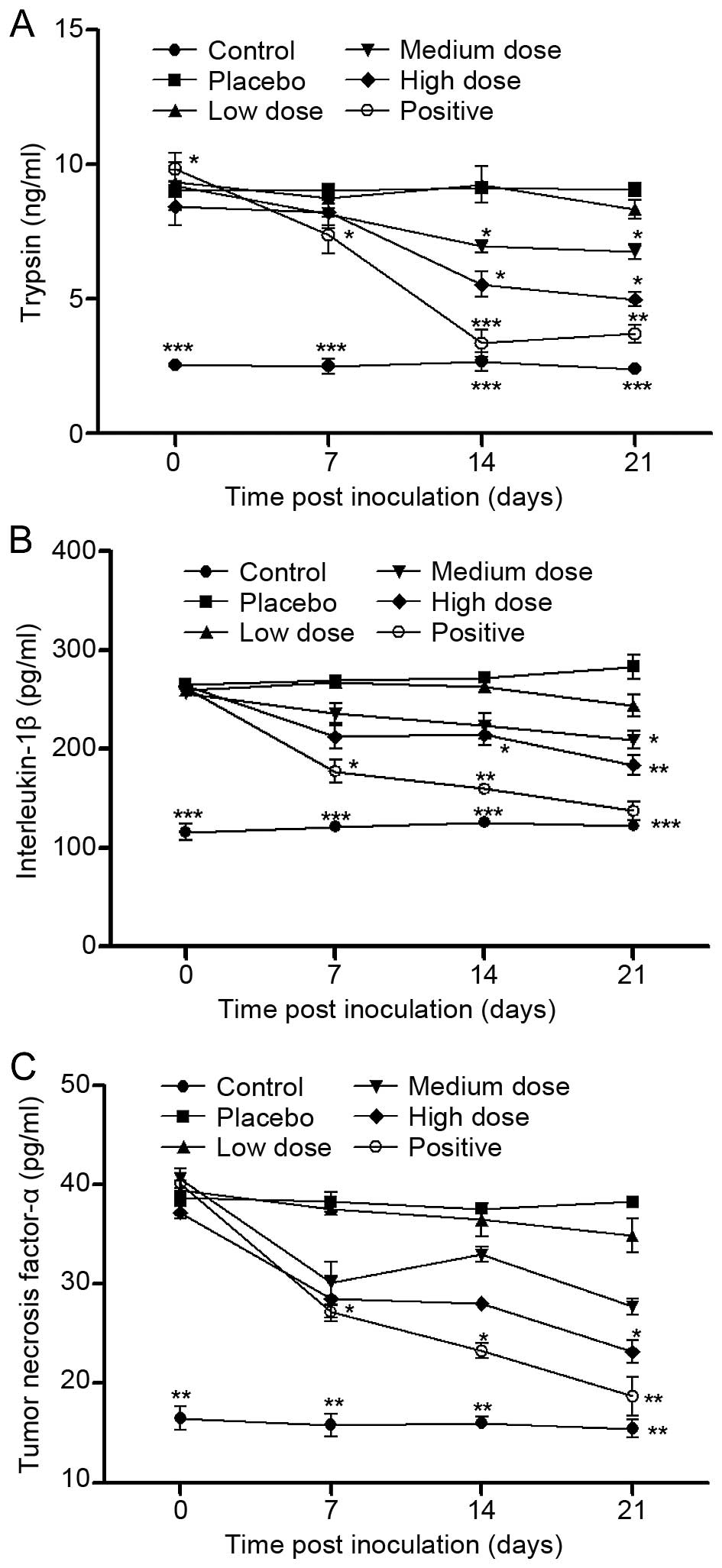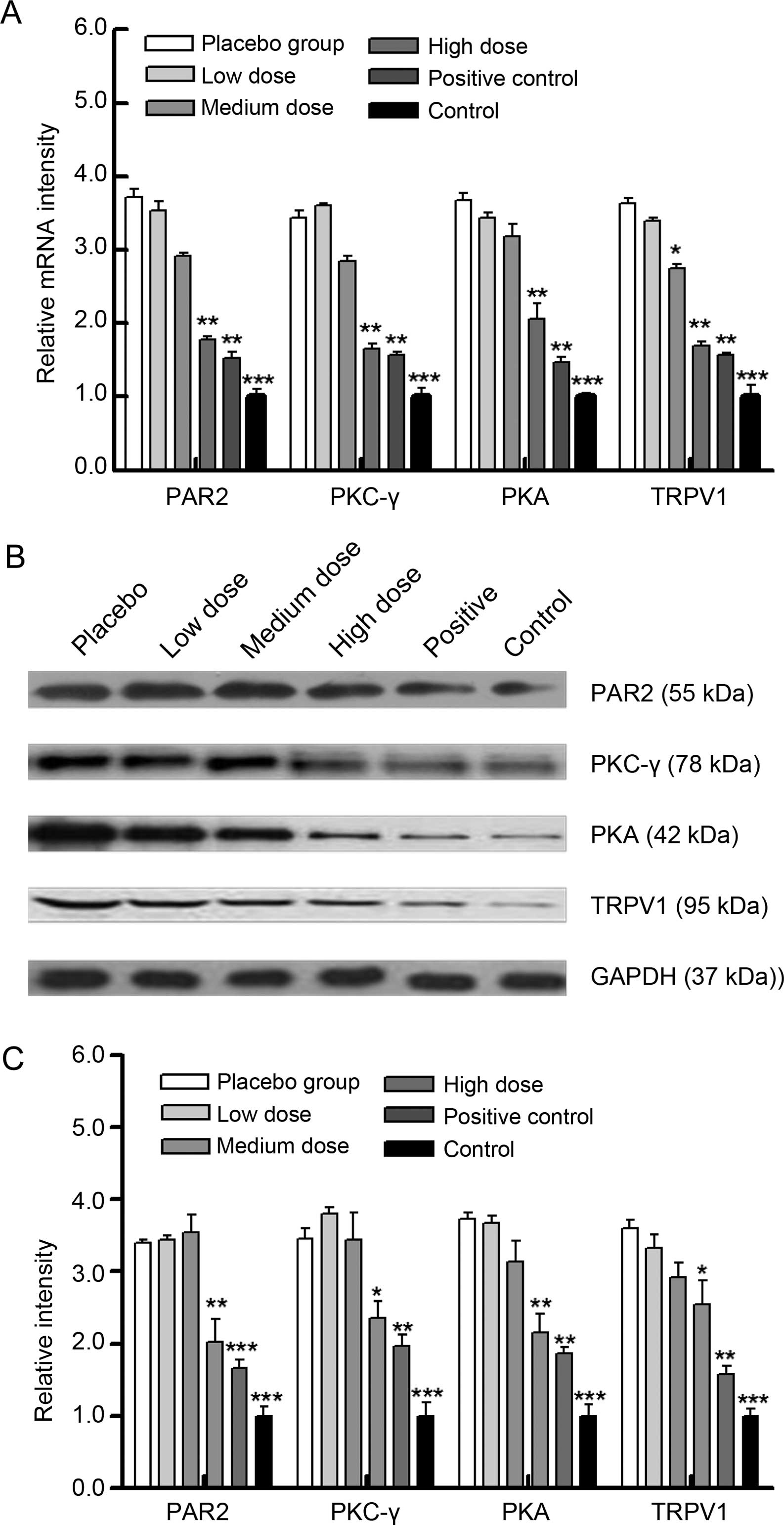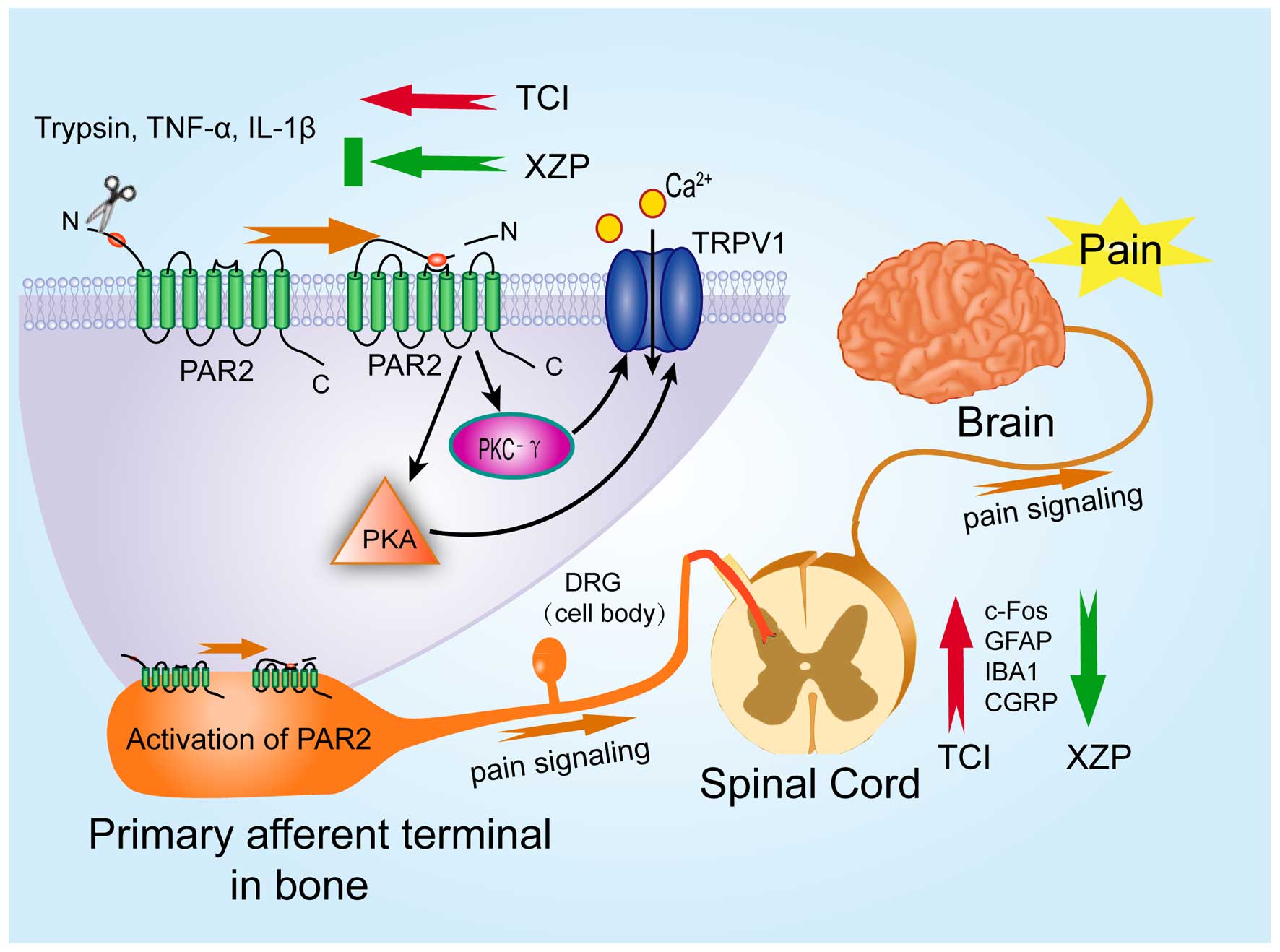|
1
|
Sabino MA and Mantyh PW: Pathophysiology
of bone cancer pain. J Support Oncol. 3:15–24. 2005.PubMed/NCBI
|
|
2
|
Mercadante S: Malignant bone pain:
Pathophysiology and treatment. Pain. 69:1–18. 1997. View Article : Google Scholar : PubMed/NCBI
|
|
3
|
Coleman RE: Clinical features of
metastatic bone disease and risk of skeletal morbidity. Clin Cancer
Res. 12:6243s–6249s. 2006. View Article : Google Scholar : PubMed/NCBI
|
|
4
|
Chow E, Zeng L, Salvo N, Dennis K, Tsao M
and Lutz S: Update on the systematic review of palliative
radiotherapy trials for bone metastases. Clin Oncol. 24:112–124.
2012. View Article : Google Scholar
|
|
5
|
Portenoy RK, Payne D and Jacobsen P:
Breakthrough pain: Characteristics and impact in patients with
cancer pain. Pain. 81:129–134. 1999. View Article : Google Scholar : PubMed/NCBI
|
|
6
|
Chan FK: Primer: Managing NSAID-induced
ulcer complications-balancing gastrointestinal and cardiovascular
risks. Nat Clin Pract Gastroenterol Hepatol. 3:563–573. 2006.
View Article : Google Scholar : PubMed/NCBI
|
|
7
|
Lapeyre-Mestre M, de Castro AM, Bareille
MP, Del Pozo JG, Requejo AA, Arias LM, Montastruc JL and Carvajal
A: Non-steroidal anti-inflammatory drug-related hepatic damage in
France and Spain: Analysis from national spontaneous reporting
systems. Fundam Clin Pharmacol. 20:391–395. 2006. View Article : Google Scholar : PubMed/NCBI
|
|
8
|
Schneider V, Lévesque LE, Zhang B,
Hutchinson T and Brophy JM: Association of selective and
conventional nonsteroidal antiinflammatory drugs with acute renal
failure: A population-based, nested case-control analysis. Am J
Epidemiol. 164:881–889. 2006. View Article : Google Scholar : PubMed/NCBI
|
|
9
|
Michaelson MD and Smith MR:
Bisphosphonates for treatment and prevention of bone metastases. J
Clin Oncol. 23:8219–8224. 2005. View Article : Google Scholar : PubMed/NCBI
|
|
10
|
Wong R and Wiffen PJ: Bisphosphonates for
the relief of pain secondary to bone metastases. Cochrane Database
Syst Rev. (2): CD0020682002.PubMed/NCBI
|
|
11
|
Wang J, Zhang R, Dong C, Jiao L, Xu L, Liu
J, Wang Z, Mao Ying QL, Fong H and Lao L: Topical treatment with
Tong-Luo-San-Jie gel alleviates bone cancer pain in rats. J
Ethnopharmacol. 143:905–913. 2012. View Article : Google Scholar : PubMed/NCBI
|
|
12
|
Bao Y, Kong X, Yang L, Liu R, Shi Z, Li W,
Hua B and Hou W: Complementary and alternative medicine for cancer
pain: An overview of systematic reviews. Evid Based Complement
Alternat Med. 2014:1703962014. View Article : Google Scholar : PubMed/NCBI
|
|
13
|
Yanju B, Yang L, Hua B, Hou W, Shi Z, Li
W, Li C, Chen C, Liu R, Qin Y, et al: A systematic review and
meta-analysis on the use of traditional Chinese medicine compound
kushen injection for bone cancer pain. Support Care Cancer.
22:825–836. 2014. View Article : Google Scholar
|
|
14
|
Xu L, Lao LX, Ge A, Yu S, Li J and Mansky
PJ: Chinese herbal medicine for cancer pain. Integr Cancer Ther.
6:208–234. 2007. View Article : Google Scholar : PubMed/NCBI
|
|
15
|
Gözüm S, Tezel A and Koc M: Complementary
alternative treatments used by patients with cancer in eastern
Turkey. Cancer Nurs. 26:230–236. 2003. View Article : Google Scholar : PubMed/NCBI
|
|
16
|
Bao Y, Gao Y, Du M, Hou W, Yang L, Kong X,
Zheng H, Li W and Hua B: Topical treatment with Xiaozheng Zhitong
Paste (XZP) alleviates bone destruction and bone cancer pain in a
rat model of prostate cancer-induced bone pain by modulating the
RANKL/RANK/OPG signaling. Evid Based Complement Alternat Med.
2015:2158922015. View Article : Google Scholar : PubMed/NCBI
|
|
17
|
Bao YJ, Hua BJ, Hou W, Lin HS, Zhang XB
and Yang GX: Alleviation of cancerous pain by external compress
with Xiaozheng Zhitong Paste. Chin J Integr Med. 16:309–314. 2010.
View Article : Google Scholar : PubMed/NCBI
|
|
18
|
van den Beuken-van Everdingen MH, de Rijke
JM, Kessels AG, Schouten HC, van Kleef M and Patijn J: Prevalence
of pain in patients with cancer: A systematic review of the past 40
years. Ann Oncol. 18:1437–1449. 2007. View Article : Google Scholar : PubMed/NCBI
|
|
19
|
Mantyh P: Bone cancer pain: Causes,
consequences, and therapeutic opportunities. Pain. 154(Suppl 1):
S54–S62. 2013. View Article : Google Scholar : PubMed/NCBI
|
|
20
|
Mao-Ying QL, Wang XW, Yang CJ, Li X, Mi
WL, Wu GC and Wang YQ: Robust spinal neuroinflammation mediates
mechanical allodynia in Walker 256 induced bone cancer rats. Mol
Brain. 5:162012. View Article : Google Scholar : PubMed/NCBI
|
|
21
|
Wang XW, Hu S, Mao-Ying QL, Li Q, Yang CJ,
Zhang H, Mi WL, Wu GC and Wang YQ: Activation of c-jun N-terminal
kinase in spinal cord contributes to breast cancer induced bone
pain in rats. Mol Brain. 5:212012. View Article : Google Scholar : PubMed/NCBI
|
|
22
|
Wang XW, Li TT, Zhao J, Mao-Ying QL, Zhang
H, Hu S, Li Q, Mi WL, Wu GC, Zhang YQ, et al: Extracellular
signal-regulated kinase activation in spinal astrocytes and
microglia contributes to cancer-induced bone pain in rats.
Neuroscience. 217:172–181. 2012. View Article : Google Scholar : PubMed/NCBI
|
|
23
|
Ke C, Li C, Huang X, Cao F, Shi D, He W,
Bu H, Gao F, Cai T, Hinton AO Jr, et al: Protocadherin20 promotes
excitatory synaptogenesis in dorsal horn and contributes to bone
cancer pain. Neuropharmacology. 75:181–190. 2013. View Article : Google Scholar : PubMed/NCBI
|
|
24
|
Yanagisawa Y, Furue H, Kawamata T, Uta D,
Yamamoto J, Furuse S, Katafuchi T, Imoto K, Iwamoto Y and Yoshimura
M: Bone cancer induces a unique central sensitization through
synaptic changes in a wide area of the spinal cord. Mol Pain.
6:382010. View Article : Google Scholar : PubMed/NCBI
|
|
25
|
Rothmeier AS and Ruf W: Protease-activated
receptor 2 signaling in inflammation. Semin Immunopathol.
34:133–149. 2012. View Article : Google Scholar
|
|
26
|
Bao Y, Hou W and Hua B: Protease-activated
receptor 2 signalling pathways: A role in pain processing. Expert
Opin Ther Targets. 18:15–27. 2014. View Article : Google Scholar
|
|
27
|
Bao Y, Hou W, Liu R, Gao Y, Kong X, Yang
L, Shi Z, Li W, Zheng H, Jiang S, et al: PAR2-mediated upregulation
of BDNF contributes to central sensitization in bone cancer pain.
Mol Pain. 10:282014. View Article : Google Scholar : PubMed/NCBI
|
|
28
|
Bao Y, Gao Y, Hou W, Yang L, Kong X, Zheng
H, Li C and Hua B: Engagement of signaling pathways of
protease-activated receptor 2 and μ-opioid receptor in bone cancer
pain and morphine tolerance. Int J Cancer. Feb 24–2015.Epub ahead
of print. View Article : Google Scholar
|
|
29
|
Bao Y, Gao Y, Yang L, Kong X, Zheng H, Hou
W and Hua B: New insights into protease-activated receptor 4
signaling pathways in the pathogenesis of inflammation and
neuropathic pain: A literature review. Channels. 9:5–13. 2015.
View Article : Google Scholar : PubMed/NCBI
|
|
30
|
Bao Y, Hou W, Yang L, Kong X, Du M, Zheng
H, Gao Y and Hua B: Protease-activated receptor 2 antagonist
potentiates analgesic effects of systemic morphine in a rat model
of bone cancer pain. Reg Anesth Pain Med. 40:158–165. 2015.
View Article : Google Scholar : PubMed/NCBI
|
|
31
|
Bao Y, Hou W, Yang L, Liu R, Gao Y, Kong
X, Shi Z, Li W, Zheng H, Jiang S, et al: Increased expression of
protease-activated receptor 2 and 4 within dorsal root ganglia in a
rat model of bone cancer pain. J Mol Neurosci. 55:706–714. 2015.
View Article : Google Scholar
|
|
32
|
Bao Y, Hua B, Hou W, Shi Z, Li W, Li C,
Chen C, Liu R and Qin Y: Involvement of protease-activated receptor
2 in nocicep-tive behavior in a rat model of bone cancer. J Mol
Neurosci. 52:566–576. 2014. View Article : Google Scholar
|
|
33
|
Hua B, Gao Y, Kong X, Yang L, Hou W and
Bao Y: New insights of nociceptor sensitization in bone cancer
pain. Expert Opin Ther Targets. 19:227–243. 2015. View Article : Google Scholar
|
|
34
|
Liu S, Liu YP, Yue DM and Liu GJ:
Protease-activated receptor 2 in dorsal root ganglion contributes
to peripheral sensitization of bone cancer pain. Eur J Pain.
18:326–337. 2014. View Article : Google Scholar
|
|
35
|
Zimmermann M: Ethical guidelines for
investigations of experimental pain in conscious animals. Pain.
16:109–110. 1983. View Article : Google Scholar : PubMed/NCBI
|
|
36
|
Lamoureux F, Baud'huin M, Rodriguez
Calleja L, Jacques C, Berreur M, Rédini F, Lecanda F, Bradner JE,
Heymann D and Ory B: Selective inhibition of BET bromodomain
epigenetic signalling interferes with the bone-associated tumour
vicious cycle. Nat Commun. 5:35112014. View Article : Google Scholar : PubMed/NCBI
|
|
37
|
Coleman RE: Metastatic bone disease:
Clinical features, pathophysiology and treatment strategies. Cancer
Treat Rev. 27:165–176. 2001. View Article : Google Scholar : PubMed/NCBI
|
|
38
|
DePuy V, Anstrom KJ, Castel LD, Schulman
KA, Weinfurt KP and Saad F: Effects of skeletal morbidities on
longitudinal patient-reported outcomes and survival in patients
with metastatic prostate cancer. Support Care Cancer. 15:869–876.
2007. View Article : Google Scholar : PubMed/NCBI
|
|
39
|
Paqueron X, Conklin D and Eisenach JC:
Plasticity in action of intrathecal clonidine to mechanical but not
thermal nociception after peripheral nerve injury. Anesthesiology.
99:199–204. 2003. View Article : Google Scholar : PubMed/NCBI
|
|
40
|
Gosselin RD, Suter MR, Ji RR and Decosterd
I: Glial cells and chronic pain. Neuroscientist. 16:519–531. 2010.
View Article : Google Scholar : PubMed/NCBI
|
|
41
|
Nakagawa T and Kaneko S: Spinal astrocytes
as therapeutic targets for pathological pain. J Pharmacol Sci.
114:347–353. 2010. View Article : Google Scholar : PubMed/NCBI
|
|
42
|
Schomberg D and Olson JK: Immune responses
of microglia in the spinal cord: Contribution to pain states. Exp
Neurol. 234:262–270. 2012. View Article : Google Scholar : PubMed/NCBI
|
|
43
|
Romero-Sandoval A, Chai N, Nutile-McMenemy
N and Deleo JA: A comparison of spinal Iba1 and GFAP expression in
rodent models of acute and chronic pain. Brain Res. 1219:116–126.
2008. View Article : Google Scholar : PubMed/NCBI
|
|
44
|
Tanga FY, Raghavendra V and DeLeo JA:
Quantitative real-time RT-PCR assessment of spinal microglial and
astrocytic activation markers in a rat model of neuropathic pain.
Neurochem Int. 45:397–407. 2004. View Article : Google Scholar : PubMed/NCBI
|
|
45
|
Hald A, Nedergaard S, Hansen RR, Ding M
and Heegaard AM: Differential activation of spinal cord glial cells
in murine models of neuropathic and cancer pain. Eur J Pain.
13:138–145. 2009. View Article : Google Scholar
|
|
46
|
Milligan ED and Watkins LR: Pathological
and protective roles of glia in chronic pain. Nat Rev Neurosci.
10:23–36. 2009. View Article : Google Scholar :
|
|
47
|
Kawasaki Y, Zhang L, Cheng JK and Ji RR:
Cytokine mechanisms of central sensitization: Distinct and
overlapping role of interleukin-1beta, interleukin-6, and tumor
necrosis factor-alpha in regulating synaptic and neuronal activity
in the superficial spinal cord. J Neurosci. 28:5189–5194. 2008.
View Article : Google Scholar : PubMed/NCBI
|
|
48
|
Viviani B, Bartesaghi S, Gardoni F,
Vezzani A, Behrens MM, Bartfai T, Binaglia M, Corsini E, Di Luca M,
Galli CL, et al: Interleukin-1beta enhances NMDA receptor-mediated
intracellular calcium increase through activation of the Src family
of kinases. J Neurosci. 23:8692–8700. 2003.PubMed/NCBI
|
|
49
|
Dolga AM, Granic I, Blank T, Knaus HG,
Spiess J, Luiten PG, Eisel UL and Nijholt IM: TNF-alpha-mediates
neuroprotection against glutamate-induced excitotoxicity via
NF-kappaB-dependent up-regulation of K 2.2 channels. J Neurochem.
107:1158–1167. 2008.PubMed/NCBI
|
|
50
|
Riazi K, Galic MA, Kuzmiski JB, Ho W,
Sharkey KA and Pittman QJ: Microglial activation and TNFalpha
production mediate altered CNS excitability following peripheral
inflammation. Proc Natl Acad Sci USA. 105:17151–17156. 2008.
View Article : Google Scholar : PubMed/NCBI
|
|
51
|
Ren BX, Gu XP, Zheng YG, Liu CL, Wang D,
Sun YE and Ma ZL: Intrathecal injection of metabotropic glutamate
receptor subtype 3 and 5 agonist/antagonist attenuates bone cancer
pain by inhibition of spinal astrocyte activation in a mouse model.
Anesthesiology. 116:122–132. 2012. View Article : Google Scholar
|
|
52
|
Lam DK, Dang D, Zhang J, Dolan JC and
Schmidt BL: Novel animal models of acute and chronic cancer pain: A
pivotal role for PAR2. J Neurosci. 32:14178–14183. 2012. View Article : Google Scholar : PubMed/NCBI
|
|
53
|
Liu S, Liu YP, Song WB and Song XJ:
EphrinB-EphB receptor signaling contributes to bone cancer pain via
Toll-like receptor and proinflammatory cytokines in rat spinal
cord. Pain. 154:2823–2835. 2013. View Article : Google Scholar : PubMed/NCBI
|
|
54
|
Dai Y, Moriyama T, Higashi T, Togashi K,
Kobayashi K, Yamanaka H, Tominaga M and Noguchi K:
Proteinase-activated receptor 2-mediated potentiation of transient
receptor potential vanilloid subfamily 1 activity reveals a
mechanism for proteinase-induced inflammatory pain. J Neurosci.
24:4293–4299. 2004. View Article : Google Scholar : PubMed/NCBI
|
|
55
|
Grant AD, Cottrell GS, Amadesi S,
Trevisani M, Nicoletti P, Materazzi S, Altier C, Cenac N, Zamponi
GW, Bautista-Cruz F, et al: Protease-activated receptor 2
sensitizes the transient receptor potential vanilloid 4 ion channel
to cause mechanical hyperalgesia in mice. J Physiol. 578:715–733.
2007. View Article : Google Scholar
|
|
56
|
Nystedt S, Ramakrishnan V and Sundelin J:
The proteinase-activated receptor 2 is induced by inflammatory
mediators in human endothelial cells. Comparison with the thrombin
receptor. J Biol Chem. 271:14910–14915. 1996. View Article : Google Scholar : PubMed/NCBI
|
|
57
|
Striggow F, Riek-Burchardt M, Kiesel A,
Schmidt W, Henrich-Noack P, Breder J, Krug M, Reymann KG and Reiser
G: Four different types of protease-activated receptors are widely
expressed in the brain and are up-regulated in hippocampus by
severe ischemia. Eur J Neurosci. 14:595–608. 2001. View Article : Google Scholar : PubMed/NCBI
|
|
58
|
Ritchie E, Saka M, Mackenzie C, Drummond
R, Wheeler-Jones C, Kanke T and Plevin R: Cytokine upregulation of
proteinase-activated-receptors 2 and 4 expression mediated by p38
MAP kinase and inhibitory kappa B kinase beta in human endothelial
cells. Br J Pharmacol. 150:1044–1054. 2007. View Article : Google Scholar : PubMed/NCBI
|
|
59
|
Zhang W, Gao J, Zhao T, Wei L, Wu W, Bai
Y, Zou D and Li Z: Proteinase-activated receptor 2 mediates thermal
hyperalgesia and is upregulated in a rat model of chronic
pancreatitis. Pancreas. 40:300–307. 2011. View Article : Google Scholar : PubMed/NCBI
|
|
60
|
Huang ZJ, Li HC, Cowan AA, Liu S, Zhang YK
and Song XJ: Chronic compression or acute dissociation of dorsal
root ganglion induces cAMP-dependent neuronal hyperexcitability
through activation of PAR2. Pain. 153:1426–1437. 2012. View Article : Google Scholar : PubMed/NCBI
|



